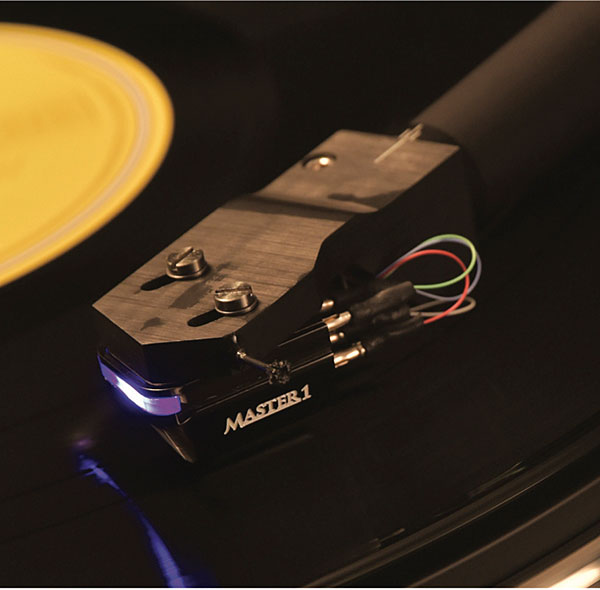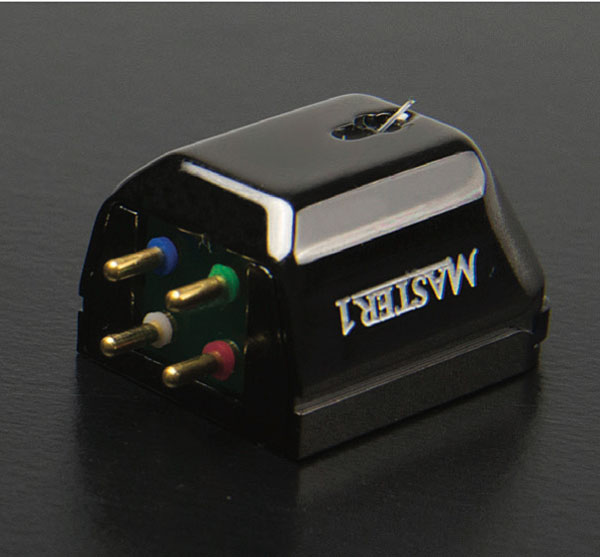| Columns Retired Columns & Blogs |
With some exceptions, most new LP pressings are junk , Just saying ..!
Carry on ...
By the time you read this, I'll have posted those 24/96 files on AnalogPlanet.com: you can listen and decide for yourself. Next up will be the CF1-09, which I'm almost afraid to try. Almost.
DS Audio Master1 optical cartridge
It wasn't a pleasant task, but I'm glad now that, in September 2015, I gave DS Audio's DS-W1 "Nightrider" optical phono cartridge ($8500 with equalizer) a less-than-glowing review. Please read that column, now posted on AnalogPlanet.com, for the full background.
The gist of what I wrote was that, unlike standard moving-magnet and moving-coil cartridges, which are velocity-sensitive devices (as are cutter heads), optical cartridges, invented and introduced in the 1970s by Toshiba, are sensitive to amplitude. Every LP in your collection was cut using a combination of constant velocity and constant amplitude, to produce, in very simplified terms, the low-frequency attenuation and treble boost that your RIAA phono stage reverses to produce a flat response in playback.

During playback, a velocity-sensitive MM or MC cartridge produces flat response for the constant-velocity portion of the groove, but a 6dB/octave rise for the constant-amplitude portion; the latter output must be compensated for by the inverse RIAA curve applied by the phono preamplifier. But the optical cartridge is an amplitude-sensitive device, whose output is proportional to the stylus's degree of physical displacement. Its frequency response will be linear (flat) only when its stylus is tracing a constant-amplitude groove modulation—under which conditions, its output rolls off at 6dB/octave.
DS Audio's task, then, was to produce, in addition to an outstanding optical cartridge, an equalizer that could reconcile the differences between what's put on the record to be decoded by a velocity-sensitive transducer, and the output of an amplitude/displacement-sensitive optical cartridge. (I really hope you go back and read the original review!)
My biggest problem with the sound of the DS-W1 was that its bass output was excessive and obtrusive, not to mention less well-defined and less coherent than the ideal. I also felt that the cartridge's dedicated equalizer just wasn't good enough for an $8500 product that had to be purchased as a system—and so the electronics couldn't be upgraded. For that money, you could do better.
DS Audio (footnote 4) now makes three optical-cartridge systems: the DS-W2, the DS002, and their top model, the Master1. You can mix and match cartridges and equalizers. (DS Audio's website is too arty for its own good and needs work.)
The Master1 cartridge and equalizer together cost $22,500. As with the DS-W1, the system outputs a line-level signal—no additional phono preamp is needed. On the other hand, if you don't like the sound, for now there's no upgrade—this is it. If you didn't already know the Master1 cartridge was an optical cartridge, you'd find out when you plugged it into a standard phono preamp: no sound.
You get a lot for $22,500, physically and sonically. The Master1 cartridge itself has a body of superhard Duralumin, a sapphire cantilever, and a MicroRidge stylus. (I'm not sure why they forsook the original's Shibata stylus.) Its mass is on the light side, at 8.1gm, and its specs resemble those of a traditional cartridge. The channel separation is specced as "more than 25dB," and the range of vertical tracking force (VTF) is 1.6–1.8gm, with 1.7gm recommended. DS provides no compliance spec, but in either VPI's Fatboy 12" tonearm with gimbal bearing (review next month, along with VPI's Avenger turntable) or Swedish Analog Technologies' new LM-09 9" arm, the resonant frequency fell within the ideal range of 8–12Hz: close to 9Hz. This puts the compliance in the range of low to medium, which is ideal for the higher-mass arms with which it's likely to be used.
The Master1 equalizer is a large metal box measuring 17.2" wide by 6.3" high by 15.6" deep and weighing 53 lb. Behind its gleaming faceplate of brushed aluminum is a power amp–sized power supply with multiple storage capacitors linked by copper bus bars. On its rear panel are three outputs, each of which uses a different equalization curve and has single-ended (RCA) and balanced (XLR) output jacks. Output 1 provides a single 6dB/octave rolloff below 30Hz; Output 2, a 6dB/octave rolloff below 50Hz and a second 6dB/octave rolloff below 30Hz; and Output 3 provides 6dB/octave rolloffs below 50Hz and 30Hz, and a rolloff of 12dB/octave below 25Hz. Turn on the equalizer and an LED that runs almost the entire length of the front panel glows a Princely purple, the level of which can be adjusted with a dial on the rear panel. (A bar on the front of the cartridge glows purple as well.)

So say the specifications. To me, Output 1 sounded considerably boosted in the low bass; it's probably the same or similar equalization to that used in the original DS-W1. Output 2's low bass sounded slightly boosted, while Output 3 provided the flattest-sounding equalization, and was what I preferred with the full-range Wilson Audio Specialties Alexx and Sonus Faber Aida loudspeakers. All three outputs produced the same smooth, gradual treble boost, which rose evenly and was not at all peaky. The sound was expansive and open, rather than noticeably bright and/or edgy.
Out of the Darkness Emerges Musical Light
Because an optical cartridge is based on a different way to retrieve information from the groove, it seems inevitable that it will sound different from any cartridge based on moving magnets or moving coils. An optical cartridge's moving mass is far lighter, so it's superfast. It is also not subject to Lenz's law: "An electric current induced by a changing magnetic field will flow such that it will create its own magnetic field that opposes the magnetic field that created it." So there's no electromagnetic interference. I immediately heard that as a freedom of mechanical movement that resulted in effortless attacks, bountiful sustain, and long decays that faded into pitch-"black" silence.
The Master1's speed, transparency, and background "blackness" made familiar solo piano recordings sound new, including Robert Silverman's Chopin's Last Waltz (IsoMike 5606), and three versions of Glenn Gould's two recordings of J.S. Bach's The Goldberg Variations: a reissue of the legendary original 1955 performance, from analog tape (Columbia Masterworks/Analog Spark ML 5060); Columbia's 1984 box, containing that recording digitized as well as Gould's 1981 digital recording; and a recent Sony reissue of the 1981 performance sourced from a recently discovered analog backup tape and cut in the Netherlands by Lex van Coeverden. Someone needs to grab that tape and do it correctly. (I've just heard from van Coeverden, who told me he cut the new LP from the file he was sent. Feh!)
Due to lack of space here, that series of comparisons will have to wait for an AnalogPlanet write-up. However, the piano sounds in all of these versions, while very different, were all tracked well by the Master1, and delivered with an enticing combination of attack delicacy and image stability, backed by that exceptionally "black" silence. They produced a nonfatiguing "listen-in" experience.
Playing the same records with Ortofon's MC Century cartridge, or the DST201 from Tedeska Analog Audio (a Berlin-based company that I'll also write about in a couple of months), produced a very different, more familiar sound that I found no less enticing—it had greater weight and solidity, with more there there. In systems that already sound forward, the Master1's rising top end may be too much.
I wish I could afford to have both of these listening experiences handy on different, equally fine tonearms, but that's beyond my means (though maybe not yours). DS Audio's Master1 optical cartridge on SAT's new LM-09 tonearm provided a festival of delicacy and detail that you should hear. Whether or not the Master1's clearly but gently rising top end will bother you is something only your ears and speakers can tell you.
Bottom line: In the Master1, DS Audio has fulfilled the promise of the original DS-W1 optical cartridge with a new, improved model and far more transparent electronics. When you hear, through this combo, Jim Horn's jazzy clarinet and Hal Blaine's woody rim shots at the conclusion of "Broken Arrow," from Buffalo Springfield's Again (LP, Atco SD33-226), you'll get the picture—especially if that track is familiar to you. I just played it and got a big, pleasant surprise!

With some exceptions, most new LP pressings are junk , Just saying ..!
Carry on ...

Hi
I see what you mean. If you put it another way: "Many old LP pressings still sound better than many new pressings", then I would fully agree with you.
Yes, my tarnished ears tell me many many old old LP pressings still sound pretty pretty good vs new pressings.
I think it is the issue of the master recording more than the pressing itself. In the old time when vaccumm tubes are the only electronics available vs the massive digital/solidstate technology employed during the entire mics/mixing/master recording nowadays.
Sonically, I find those old stereo/mono classical music LPs I got (some 1,000+), olders sound better (of 1960 era), in term of OPENness, airy & lifelike. None of my 30+ digital mastered
LPs sound as good, just like confined in a box despite they all sound clear, clean, punchy & digitally 'correct'.
As I just posted in the phono-cartridge forum here, I was very pleasantly surprised when I played the first time the old Columbia Masterworks label LP: the French Opera Arias sung by Richard Tucker with The Vienna State Opera Orchestra conducted by Pierre Dervaux.
(1960s ?)
Virtually, I found myself sitting at the front 3rd row centre of the oera house (vs my favourite seat: 10-13th row centre). The performance sounds so live, open, powerful & engaging. WOW! Like the tener (a native from Brooklyn, NY) singing right above me on the podium. I have not had such live performance enjoyment at home before.
Listening is believing
Jack L

Junk , care to elaborate ?
I haven't bought a vinyl in decades but would still have to say that the old pressings were never all that good. ( of course there were exceptions which might be why old HP confined himself to Vintage Living Presence ) .
Mr.Kassem seems to have bought-up the available Presses and is in the process of rebuilding as many as he can. He sells his fresh vinyl for $30 to $100 ea.
Vinyl is an astonishingly expensive hobby Now-a-days ! ( it was never cheap with the 1980s Koetsus, that I collect, originally costing $1,000 ).
Tony in Venice Florida
ps. Are $25,000 to $50,000 tonearms affordable ?


Hi
Yes & NO.
If you play vinyl SMARTLY like me, you don't have to auction yr mom to get into the habit.
I've used my ears & my HEAD, to enjoy vinyl music big big-time without wrecking my bank account a bit !
Like everything else, play smart to get ahead of the game !
Jack L

... "https://swedishat.com/SAT%209" is still not working.
Perhaps this is the link that is intended:
"https://swedishat.com/SAT%209%22%20vs%2012%22%20paper.pdf"